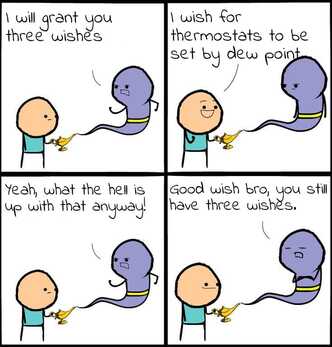|
In our Energy Smart Home Performance practice, we’ve ended up using Carrier Infinity heat pumps almost exclusively because of their controls feature set, which fits well with our penchant for home electrification. Yet their technical support is lacking, along with major holes in data transparency. Thanks to the fast feedback loops from data logging thermostats and indoor air quality monitors we’ve learned a lot about how equipment interacts with homes. This lets us understand what works and what doesn’t, and has helped us deliver remarkable comfort and air quality results for our clients. Now we’re focused on teaching others to offer the same customized solutions through the HVAC 2.0 process. So far, we’ve cobbled things together, but as HVAC 2.0 grows and BAD ASS HVAC becomes common, a more cohesive set of controls and features are needed so that a large volume of these systems can be more easily sold, commissioned, and monitored. Every product we have evaluated has some useful features but lacks others. So below we are building a list of the things we’d like and one feature that is absolutely required to be recommended within the HVAC 2.0 contractor network. Here’s our one must have, then our wish list. Contractors: please comment about what you like, don’t like, and what you think is missing! Required Feature - Electric Reheat Dehumidification
Products we are aware of that offer electric reheat dehumidification:
Hopefully soon we can shift from short listing companies that offer reheat, to short listing the companies that don’t do reheat. Dew Point Control Is a temperature and relative humidity to dew point conversion difficult to code into a digital thermostat? Managing relative humidity is a pain when clients choose different temperature set points. We’ve learned to really care about dew point temperature, as dew point is a good proxy for specific humidity and it lets us more efficiently manage for IAQ and durability. Also, when indoor and outdoor dew points are comparable, there is a lot to be learned! It is true that homeowners don’t know this metric well, but it’s not that hard to teach, especially with examples available at www.dpcalc.org. The beneficial difference in dehumidification performance by dew point control vs. relative humidity has the potential to win over contractors and homeowners, which can make your equipment a standout among competitors. John Oaks, Utah commercial HVAC tech extraordinaire and HVAC 2.0 member made a meme about dew point controls. The need for this is real, and cannot be overemphasized. Please make this happen.
Cold Climate Heat Pumps Electrification of homes is gaining traction. Our small practice, Energy Smart Home Performance, has removed 10 natural gas meters as well as propane and oil tanks from our project houses. Completely without government programs, by the way. Doing this without driving up homeowner utility costs (we’ve even reduced energy costs in some cases) requires inverter driven heat pumps. The Carrier VNA0 has by far the best cold temp performance of any product that offers reheat dehumidification. (Hey Mitsubishi and Daikin, hint, hint! Your cold temp performance is excellent, please consider electric reheat!) Here’s what we’d like to see:
Dashboard Ecobee thermostats have a very useful web based data logging tool. Early on in our learning, watching equipment performance under varying outdoor conditions taught us a lot about how homes perform. They also helped provide equipment sizing reconciliation aka “real world load calcs.” If equipment under worst load outdoor temperatures only runs 20 minutes an hour, it’s pretty clear the equipment is 2 to 3 times oversized. Later, we added air quality monitors to get deeper insights and faster feedback on comfort and air quality. Charts created from this data have helped us learn very quickly how important fresh, filtered, dehumidified air is. Based on what we’ve gleaned from all of this data, here are features we’d like:
Energy Use On board current transmitters (CTs) to monitor energy usage of various functions. This usage should be viewable and downloadable from the dashboard. Daily, monthly, and annual usage at a minimum. This information has saved us from and helped us solve countless problems. It has also increased our confidence in selling aggressively sized heat pumps. Carrier Infinity and equivalent ICP controls already have these reporting features:
Indoor Air Quality HVAC 2.0 naturally leans consumers towards feature laden equipment, and in cold climates higher efficiency heat pumps are best for electrification. If you aren’t familiar with the BAD ASS HVAC design, see it here… BAD ASS HVAC provides pretty good IAQ control with a simple system, but some will want more integrated information and control. Check out Tzoa Haven. It needs to work with communicating equipment since that’s most of what HVAC 2.0 sales are.
Temperature Control Clients tend to focus myopically on what the thermostat temperature display says rather than if they are comfortable or not. This often leads to large setbacks and running at the edge of comfort trying to adhere to Jimmy Carter’s “set it at 68 and wear a sweater” suggestion. This is not a critical feature, but a number of HVAC 2.0 members have mentioned it to me. We suggest:
Conclusion Admittedly, this is a lot to ask for. Note that every feature (except dew point targets) exists in one piece of residential equipment or another. With the exception of CT clamps and better cold temp performance, these are all software changes, not hardware. 85% of all residential equipment sold are single stage configurations that deliver poor comfort and low customer satisfaction. If we want to shift away from this, and create demand for more capable systems, we need to establish better experiences for our clients both in the sales process and in how their homes feel. 87% of residential HVAC is sold on an emergency basis with high urgency and little planning. This makes both homeowner and contractor lives harder during install, and delivers poor comfort for homeowners as well. HVAC 2.0 has potential to shift both of the above percentages toward higher sales of feature-laden equipment. This occurs by educating consumers on the benefits of this equipment, while also encouraging them to replace their existing equipment before it fails on a very hot or cold day. Consumer satisfaction goes up as emergency equipment replacements goes away. Contractor satisfaction goes up by increased sales and equipment installations during slow seasons. Manufacturer satisfaction goes up with an increase in feature-laden equipment sales. Everybody wins. Being able to see how equipment is running gives fast feedback loops to contractors and clients, avoids unnecessary trips, and helps us understand with much better clarity what is working, what isn’t, and why. When it isn’t working, we might be able to diagnose it remotely or at least go in with ideas. Our HVAC 2.0 process is built to do all this. But we need some help on the equipment side. How soon can these changes hit the market? Want help building these features? We’re available to consult. Email me at nate@energysmartohio.com. |
AuthorNate Adams is fiercely determined to get feedback on every project to learn more about what works and what doesn't. This blog shows that learning process. |
ServicesCompany |
Buy The Home Comfort Book!
© COPYRIGHT 2017. ALL RIGHTS RESERVED.
|
 RSS Feed
RSS Feed


